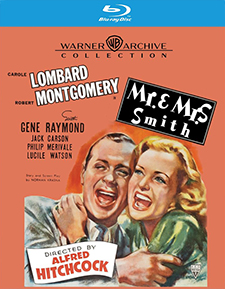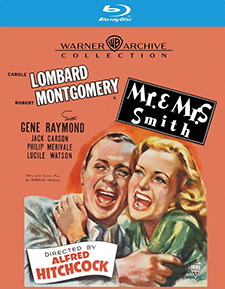Mr. & Mrs. Smith (1941) (Blu-ray Review)

Director
Alfred HitchcockRelease Date(s)
1941 (June 25, 2024)Studio(s)
RKO Radio Pictures (Warner Archive Collection)- Film/Program Grade: B-
- Video Grade: A
- Audio Grade: A
- Extras Grade: B
Review
Director Alfred Hitchcock rightfully earned the title “Master of Suspense” with such suspense classics as The 39 Steps, Strangers on a Train, and Notorious. Shortly after his arrival in the United States, however, he took the reins of a decidedly different sub-genre—the screwball comedy—in Mr. & Mrs. Smith.
Manhattan attorney David Smith (Robert Montgomery, Night Must Fall) receives a visit at his office from small-town government clerk Harry Deever (Charles Halton, Address Unknown). Deever explains that David’s marriage of three years to Ann Krausheimer (Carole Lombard, Nothing Sacred) is not technically legal because of a bureaucratic mistake on the license. He returns the $2 license fee and suggests the couple just get married again to make it officially legal. This occurs after the couple had argued that morning over a hypothetical question Ann poses: “If you had it to do all over again, would you marry me?” David replied honestly that he wouldn’t; he’d remain single. Ann was not pleased.
Afterward, Deever stops at the Smiths’ apartment to tell Ann the news. Unperturbed, Ann knows all will be well. David is taking her out that night to the same restaurant where he proposed to her. She’s certain he will pop the question there once again. But things don’t work out as she expected. Ann’s skirt is too tight, the restaurant has changed ownership and now is a rundown joint, and during the evening David says not a word about remarrying.
Incensed, Ann blows up when they get home and kicks David out of the apartment even though he agrees to marry her. Soon, Ann is courted by David’s law partner, Jeff Custer (Gene Raymond, Flying Down to Rio), while David goes on a terrible blind date arranged by his friend Chuck (Jack Carson, A Star Is Born). Matters get even more complicated when Jeff takes Ann to the New York World’s Fair and a Lake Placid ski lodge and eventually proposes to her.
Made at the height of Hollywood’s screwball comedy craze, Mr. & Mrs. Smith never attains the comic lunacy of The Awful Truth or Bringing Up Baby. Lombard is in her element here as the sophisticated beauty who manages to turn a slight hiccup into a comical romp. The secret of playing broad comedy is to embrace the silly situations as perfectly normal and to react without overemphasizing their ridiculousness. Yet even Lombard couldn’t get this comedy airborne.
The film does have a few very funny scenes. In one, when David takes Ann to the restaurant that holds fond memories for both, they dine outdoors as neighborhood ragamuffins gather to gawk at the well-dressed grownups dining on the grubby street. In another, Chuck brings two floozies to a nightclub, one as a date for David, and Ann also shows up with new beau Jeff. When Ann and David spot each other across the room, David pretends to be whispering sweet nothings to an attractive woman seated next to him. Later, for an excuse to leave early, he gives himself a nosebleed, only to have one of the floozies pounce on him to administer aggressive first aid.
Montgomery is colorless in comparison with Lombard. Rather stiff and stuffy, he never achieves her level of zaniness, making for an out-of-balance teaming. The script by Norma Krasna has some good lines, but the film feels as if it’s struggling against itself to create the wild and wooly style required. Real wit is in short supply.
Mr. & Mrs. Smith is the only American comedy Hitchcock ever directed, though he did direct lighter films with Under Capricorn and The Trouble with Harry. Lombard asked specifically that Hitchcock direct Mr. & Mrs. Smith and he agreed as a favor to her. She was also responsible for getting Robert Montgomery as her leading man. Hitchcock would have preferred Cay Grant. Lombard would make only one more film, To Be or Not to Be, before dying in a plane crash in 1942 at age 33.
The film is a real curiosity in Alfred Hitchcock’s oeuvre. He incorporated humor into his thrillers effortlessly, but with this comedy, he seems perplexed as to how to milk constant laughs. It has its moments, but there should be a lot more chuckles. Lombard is responsible for generating most of the laughs and has some amusing slapstick moments, but even she can’t enliven Krasna’s ho-hum script and Hitchcock’s lifeless direction.
Mr. & Mrs. Smith was shot by director of photography Harry Stradling on 35 mm black & white film with spherical lenses and presented in the aspect ratio of 1.37:1. Picture clarity and contrast on the Blu-ray from the Warner Archive Collection are excellent. There are no surface imperfections to impede enjoyment. Details are well delineated in patterns of Lombard’s dresses, grain in log walls of the ski lodge, clutter in the Smiths’ bedroom, and decor in the nightclub. Unlike in other Hitchcock films, photography is fairly routine. Actors are filmed mostly from waist level and there are no especially eye-catching shots. Back-screen projections are used to simulate outdoor settings for scenes filmed within the studio.
The soundtrack is English 2.0 DTS-HD Master Audio. English SDH subtitles are an available option. Dialogue is clear and distinct. Sound effects include smashing dishes and glassware, ambient nightclub noise, Montgomery hitting his nose repeatedly with a salt shaker, and car engines. There are no problems with crackling or popping, making for a smooth listening experience.
Bonus materials on the Blu-ray release from Warner Archive include the following:
- Mr. Hitchcock Meets Mr. Smith (16:06)
- Holiday Highlights (7:35)
- Stage Fright (7:23)
- Cinderella’s Feller (19:34)
- Lux Radio Theater Broadcast (59:46)
- Screen Guild Radio Broadcast (29:34)
- Trailer (:47)
Mr. Hitchcock Meets Mr. Smith – Peter Bogdanovich calls Mr. & Mrs. Smith the most atypical of Hitchcock’s films. Lombard, the “Queen of Screwball Comedy,” is a “self-amused presence in her films.” Robert Osborne refers to Lombard as one of the great dames of Hollywood. Hitchcock’s daughter, Pat Hitchcock O’Connell, offers personal recollections about the friendship between Carole Lombard and her father. Both Lombard and Montgomery are proficient performers. “It’s fascinating to watch Hitchcock do a comedy.” Film historian Richard Schickel and director Richard Franklin offer their personal observations of the film. Hitchcock made Mr. & Mrs. Smith not long after coming to the United States. Regarding Hitchcock’s attitude toward actors, Schickel, who had interviewed Hitchcock, postulates that during his British period, he resented the fact that some of his actors had to leave the set early to perform on stage. He felt they looked down on film, which was Hitchcock’s passion.
Holiday Highlights – This 1940 Technicolor Merrie Melodies cartoon, directed by Tex Avery, contains blackout gags about the holidays. For New Year’s Day, a baby speaks in a loud, grown-up voice. On Valentine’s Day, it’s leap year, so the girl turns romantically aggressive on the boy. On Washington’s Birthday, the cherry tree story gets a new spin. On Easter, a rabbit is menaced by a fox who turns out to be a charmer. On Halloween, a witch rides a broomstick trailing an advertising sign. Christmas depicts Santa’s sleigh as an ice cream truck. The biggest gag is April’s Fool, when no picture at all is shown.
Stage Fright – Two dogs wander into a theater and cause mischief with sets and props. They cross paths with an angry bird, a magician’s rabbit, and a playful seal as they pursue an elusive bone. Made in 1940, this Technicolor Merrie Melodies Warner Bros. cartoon was directed by Chuck Jones. Mel Blanc provides voice characterizations.
Cinderella’s Feller – This 1940 live action Technicolor two-reeler is a musicalized version of the famous fairy tale with the principal characters—Cinderella, Prince Charming, the stepsisters—all played by children. Featuring lush production values—colorful costumes, elaborate sets, and both ballet and tap numbers—the film has a weird vibe with kids dressed in 18th century finery and wigs. Juanita Quigley and Scotty Beckett star as Cinderella and the Prince, respectively. The Prince and Cinderella get married at the end. And remember, they’re played by kids.
Lux Radio Theater Broadcast (Audio Only) – This adaptation of Mr. & Mrs. Smith, aired originally on June 9, 1941, stars Carole Lombard and Bob Hope. The program is introduced by Hollywood director Cecil B. DeMille.
Screen Guild Radio Broadcast (Audio Only) – This adaptation of Mr. & Mrs. Smith, aired originally on February 8, 1942, stars Errol Flynn and Lana Turner.
Fans of screwball comedy will find that Mr. & Mrs Smith isn’t daring enough in building the story into a collection of misunderstandings, slapstick, witty repartee, and oddball situations. A lot of the picture falls flat, but it’s worth a look, if only to enjoy Carole Lombard’s performance and to see how Alfred Hitchcock handled a genre new to him.
- Dennis Seuling

